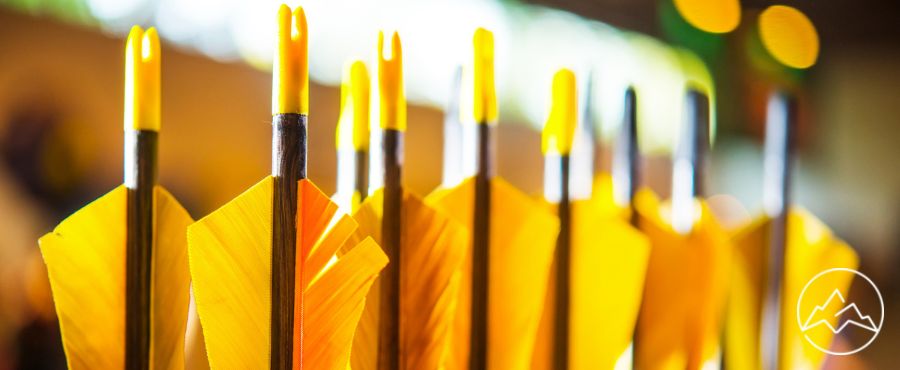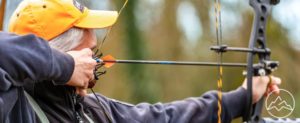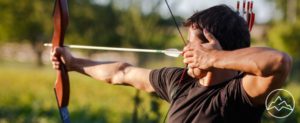Choosing the perfect arrow fletching is like finding the right balance in a symphony – it requires precision, expertise, and careful consideration. This critical decision directly influences the performance and accuracy of an archer’s shots. Two main types of fletching materials, feathers and vanes, offer distinct advantages and trade-offs. Feathers, commonly used for traditional bows and wooden arrows, lack durability and waterproofing. In contrast, vanes, made of plastic or mylar, are preferred due to their durability, water-resistance, and consistency in size and weight. The style of fletching, whether straight, offset, or helical, further impacts arrow speed, stability, and accuracy. Additionally, the length and height of the fletching play a role in arrow performance, catering to specific needs such as accuracy or speed. With various options available, such as Bohning Blazer Broadhead Vanes, Bohning Air Vanes, and Gateway Feathers Right-Wing Archery Feathers, archers can find the ideal fletching to suit their individual preferences and requirements.
Key Takeaways
- There are two main types of arrow fletching materials: feathers and vanes.
- Vanes, made of plastic or mylar, are more popular because they are durable, water-resistant, and consistent in size and weight.
- Fletching can be placed on an arrow in three main styles: straight, offset, and helical.
- Choosing the right arrow fletching depends on personal needs and preferences, with trade-offs between stability, speed, and weight.
Types of Fletching
There are two main types of arrow fletching materials, feathers and vanes, which are used for different types of bows and arrows. Feather fletching is commonly used for traditional bows and wooden arrows. It has the advantage of being lightweight and providing a natural appearance. However, feathers are not waterproof and can be easily damaged, making them less durable compared to vanes. On the other hand, plastic vanes, commonly made of materials like plastic or mylar, offer several advantages. They are durable, water-resistant, and consistent in size and weight. Plastic vanes provide better stability and steering compared to feathers, especially at longer distances. However, they may not provide the same natural appearance as feathers. Additionally, plastic vanes can be more expensive than feathers, but their longevity and performance make them a popular choice among archers.
Factors to Consider
One crucial aspect to take into account when selecting the optimal fletching for arrows is the impact of fletching height on stability and spin, akin to a delicate dance between airflow and arrow flight. The height of the fletching refers to the distance from the base of the fletching to the top. Here are four important factors to consider regarding fletching height:
- Stability: Longer fletching provides greater stability to the arrow during flight. It helps to keep the arrow on a straighter path and reduces the chances of it veering off course.
- Spin: Fletching height also affects the amount of spin the arrow experiences. Higher fletching height creates more spin, which can enhance stability and accuracy, particularly at longer distances.
- Clearance: It is important to consider the clearance between the fletching and the bow’s arrow rest. Higher fletching height may cause clearance issues with certain arrow rests, affecting the arrow’s flight and accuracy.
- Arrow speed: Longer fletching can slow down arrow speeds due to increased drag. This trade-off between stability and speed should be considered based on personal preferences and shooting requirements.
When choosing the perfect arrow fletching, it is essential to consider these factors in conjunction with the fletching materials and styles to achieve the desired balance of stability, spin, and arrow speed.
Recommended Options
Recommended arrow fletching options include Bohning Blazer Broadhead Vanes, Bohning Air Vanes, and Gateway Feathers Right-Wing Archery Feathers. When considering arrow fletching options, it is important to weigh the pros and cons of feathers versus vanes. Feathers, commonly used for traditional bows and wooden arrows, provide a traditional aesthetic but are not waterproof or very durable. On the other hand, vanes made of plastic or mylar are more popular due to their durability, water-resistance, and consistent size and weight. Fletching size and height also play a crucial role in arrow stability and performance. Longer fletching provides increased stability but can slow down arrow speeds. Additionally, fletching height affects stability and spin. Ultimately, the choice of arrow fletching depends on personal needs and preferences, taking into consideration trade-offs between stability, speed, and weight.
Frequently Asked Questions
How do I know if my arrow fletching is too long or too short for optimal performance?
Determining arrow fletching length is crucial for optimal performance. Several factors affect arrow fletching performance, including length. Research suggests that longer fletching provides greater stability but reduces arrow speed. Conversely, shorter fletching increases arrow speed but may compromise stability. To determine the ideal fletching length, archers should consider their specific needs and preferences, balancing stability, speed, and weight. Experimentation and testing different fletching lengths can help identify the optimal choice for individual performance and shooting style.
Can I mix different types of fletching materials on my arrows?
Mixing fletching materials on arrows is possible, but it is not recommended due to the potential negative impact on arrow flight and performance. Fletching materials have different characteristics, such as weight and flexibility, which can affect arrow stability and accuracy. Mixing materials may result in imbalances and inconsistencies, leading to erratic arrow flight. Additionally, it is important to consider fletching length when selecting materials, as longer fletching provides more stability but slows down arrow speeds. Therefore, it is advisable to choose a consistent fletching material for optimal performance.
Are there any specific fletching styles that are better suited for certain types of archery?
While there is no one-size-fits-all answer to the question of which fletching style is better suited for certain types of archery, there are some considerations to keep in mind. For traditional archery, where accuracy and forgiveness are important, offset or helical fletching styles are often preferred. These styles create spin and stabilization during flight, enhancing accuracy. On the other hand, compound archery, which prioritizes speed, may benefit from straight fletching styles that allow for faster arrow release. Additionally, the size of the fletching can impact arrow stability, with larger fletching providing more stability but potentially slowing down arrow speeds.
How often should I replace my arrow fletching?
Arrow fletchings typically last for a considerable amount of time, depending on various factors such as usage, material, and quality. However, it is generally recommended to inspect the fletchings regularly for signs of wear and damage. Common indicators that arrow fletching needs to be replaced include fraying, tears, or missing sections. Additionally, if the fletchings become loose or unbalanced, it may be necessary to replace them to maintain arrow stability and accuracy during flight.
Do different arrowhead types require specific fletching styles or materials for optimal flight?
Different arrowhead types do not necessarily require specific fletching styles or materials for optimal flight. However, the choice of fletching can impact arrow performance when paired with different arrowhead types. For example, certain fletching materials like feathers may be more suited for traditional arrowheads, while vanes made of plastic or mylar may be better for modern arrowheads. Additionally, the fletching style, such as straight, offset, or helical, can affect arrow stability and accuracy when used with different arrowhead types. It is important to consider these factors when selecting arrow fletching.
Conclusion
In conclusion, selecting the ideal arrow fletching is a critical decision that can greatly impact an archer’s performance and accuracy. Feathers and vanes are the two main materials used, with vanes being favored for their durability, water-resistance, and consistency. Fletching styles, such as straight, offset, and helical, each offer their own advantages and trade-offs in terms of speed, stability, and accuracy. Additionally, the length and height of the fletching also play a role in arrow performance, with larger vanes prioritized for accuracy and smaller vanes preferred for speed. Recommended options include Bohning Blazer Broadhead Vanes, Bohning Air Vanes, and Gateway Feathers Right-Wing Archery Feathers. For those who dislike gluing, Archery Products QuickFletch Twister Vanes provide a convenient alternative. Ultimately, choosing the right arrow fletching depends on individual needs and preferences, taking into account materials, styles, size, and weight.












